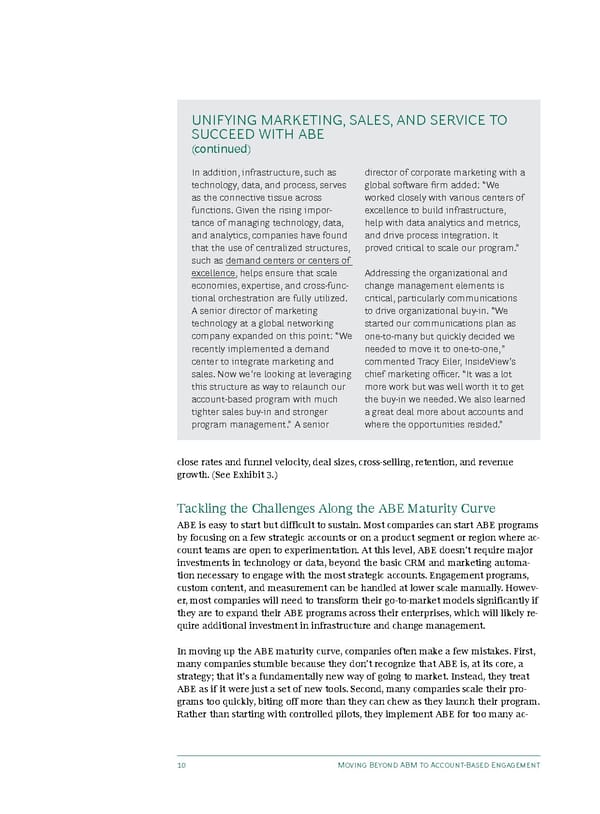UNIFYING MARKETING, SALES, AND SERVICE TO SUCCEED WITH ABE (continued) In addition, infrastructure, such as director of corporate marketing with a technology, data, and process, serves global software firm added: “We as the connective tissue across worked closely with various centers of functions. Given the rising impor- excellence to build infrastructure, tance of managing technology, data, help with data analytics and metrics, and analytics, companies have found and drive process integration. It that the use of centralized structures, proved critical to scale our program.” such as demand centers or centers of excellence, helps ensure that scale Addressing the organizational and economies, expertise, and cross-func- change management elements is tional orchestration are fully utilized. critical, particularly communications A senior director of marketing to drive organizational buy-in. “We technology at a global networking started our communications plan as company expanded on this point: “We one-to-many but quickly decided we recently implemented a demand needed to move it to one-to-one,” center to integrate marketing and commented Tracy Eiler, InsideView’s sales. Now we’re looking at leveraging chief marketing officer. “It was a lot this structure as way to relaunch our more work but was well worth it to get account-based program with much the buy-in we needed. We also learned tighter sales buy-in and stronger a great deal more about accounts and program management.” A senior where the opportunities resided.” close rates and funnel velocity, deal sizes, cross-selling, retention, and revenue growth. (See Exhibit 3.) Tackling the Challenges Along the ABE Maturity Curve ABE is easy to start but difficult to sustain. Most companies can start ABE programs by focusing on a few strategic accounts or on a product segment or region where ac- count teams are open to experimentation. At this level, ABE doesn’t require major investments in technology or data, beyond the basic CRM and marketing automa- tion necessary to engage with the most strategic accounts. Engagement programs, custom content, and measurement can be handled at lower scale manually. Howev- er, most companies will need to transform their go-to-market models significantly if they are to expand their ABE programs across their enterprises, which will likely re- quire additional investment in infrastructure and change management. In moving up the ABE maturity curve, companies often make a few mistakes. First, many companies stumble because they don’t recognize that ABE is, at its core, a strategy; that it’s a fundamentally new way of going to market. Instead, they treat ABE as if it were just a set of new tools. Second, many companies scale their pro- grams too quickly, biting off more than they can chew as they launch their program. Rather than starting with controlled pilots, they implement ABE for too many ac- 10 Moving Beyond ABM to Account-Based Engagement
 BCG moving beyond ABM to account based engagement Page 11 Page 13
BCG moving beyond ABM to account based engagement Page 11 Page 13